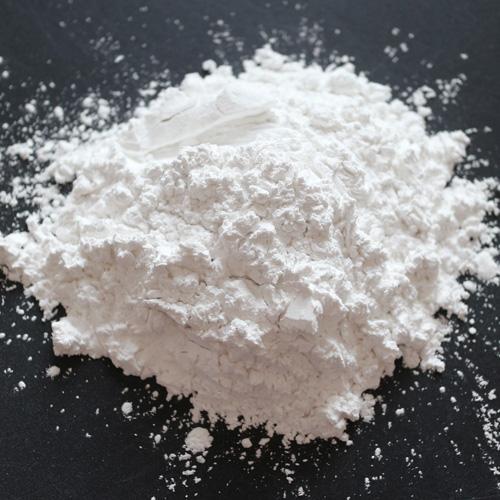
Calcined alumina is a product obtained by calcining aluminum hydroxide at high temperature to partially or almost completely convert it into aAl2O2.
Calcined alumina powder for refractory material
Calcined alumina powder is a product obtained by calcining aluminum hydroxide at high temperature to partially or almost completely convert it into aAl2O2. Calcined alumina can be classified into many grades according to calcination (crystal size, specific surface area) and Na2O content (0.01%~0.5%). The so-called industrial alumina (or industrial alumina) in our country is a kind of calcined alumina, but its general calcination degree is poor.
The production methods of calcined alumina mainly include Bayer method, soda lime sintering method, and Bayer-sintering combined method.
The smaller the particle size of a-alumina micropowder, the higher the activity, the better the dispersibility, and the better the water reducing effect and dispersibility in the castable. In the case of the same ratio and the same amount of addition, the addition of alumina fine powder with small particle size improves the construction performance of the castable, the bulk density is large, and the flexural strength and compressive strength at room temperature and high temperature are higher than those with large particle size. Alumina micropowder castable. For the alumina powder with large particle size, the fluidity of the castable decays faster, and the working time of the castable becomes shorter.
The greater the amount of alumina powder added, the better the fluidity of the castable. This is because the alumina micropowder has a small particle size and can be filled into the gaps and flocculation structures between particles.
The higher the amount of alumina added, the higher the high temperature cold flexural strength of the castable, because a large number of staggered CA2 and CA6 crystals are formed in the matrix, forming a network-like structure in the matrix.
|
type |
Project |
Al2O3% |
SiO2% |
Fe2O3% |
Na2O3% |
burn |
true density(g/cm3) |
α-Al2O3 |
|
low sodium |
AN-03 |
99.5 |
0.06 |
0.03 |
0.03 |
0.10 |
3.97 |
95 |
|
AN-05 |
99.5 |
0.06 |
0.03 |
0.05 |
0.10 |
3.97 |
95 |
|
|
AN-10 |
99.3 |
0.08 |
0.04 |
0.10 |
0.10 |
3.96 |
95 |
|
|
AN-20 |
99.0 |
0.10 |
0.05 |
0.20 |
0.20 |
3.95 |
93 |
|
|
medium sodium |
AN-30 |
99.5 |
0.04 |
0.04 |
0.30 |
0.20 |
3.93 |
90 |
|
AN-40 |
99.0 |
0.10 |
0.05 |
0.40 |
0.20 |
3.90 |
85 |
|
|
AN-50 |
97.0 |
0.15 |
0.10 |
0.50 |
0.40 |
3.85 |
80 |
Advantages of a-alumina powder:
smaller particle size
higher activity
better dispersion
The better the water-reducing effect and dispersibility in the castable
Silica bricks for coke ovens are siliceous refractory products used for building coke ovens with tridymite as the main crystal phase. Coke oven silica bricks are used to build regenerator walls, ramps, combustion chambers, carbonization chambers and furnace roofs of coke ovens. Silica brick is an acid refractory material with good resistance to acid slag erosion. The softening temperature under load is as high as 1640-1670 °C, and the volume is relatively stable in long-term use at high temperature.
low porosity clay bricks are mainly used in the regenerators of glass kilns. They can also be used in blast furnaces and hot blast furnaces in the steel industry; cement kilns in the building materials industry; chemical kilns in the chemical industry as kiln linings
Magnesia chrome bricks are refractory products with magnesia (MgO) and chromium trioxide (Cr2O3) as the main components, and periclase and spinel as the main mineral components. The main raw materials for the manufacture of magnesia-chrome bricks are sintered magnesia and chromite.
Anti stripping high alumina bricks are referred to as anti-stripping bricks or anti-stripping refractory bricks. Anti-stripping high-alumina bricks are widely used in my country's new dry process kiln, Libore kiln and wet process kiln, including kiln door cover, rising flue, cooling zone, decomposition zone, safety belt, transition zone, coolant rear Walls and side walls and beams with curved ceilings.
Fireclay bricks are classified as weak acid refractories. Due to the large fluctuation range of chemical composition, different production methods, and differences in firing temperature, the properties of clay bricks change greatly.We can produce all kinds of Fireclay bricks according to customers' requirements
The chemical composition of bauxite is mainly Al2O3, SiO2, Fe2O3, TO2, accounting for about 95% of the total composition, and the secondary components are CaO, MgO, K2O, Na20, S, MnO2 organic matter and trace components Ga, Ge, etc.
Silica brick is an acidic refractory mainly composed of tridymite, cristobalite and a small amount of residual quartz and glass phases
In recent years, bauxite powder and bauxite have been widely used in common cast steel coatings and cast iron coatings due to their high fire resistance, good chemical stability, small expansion coefficient, rich source and low price.



